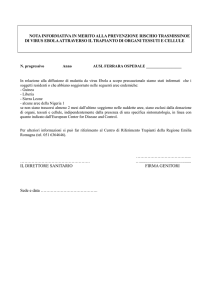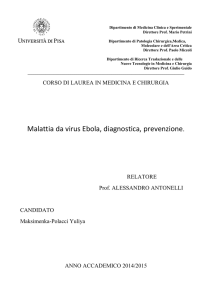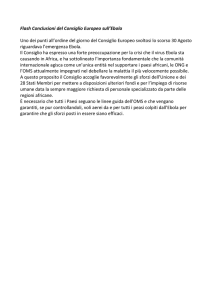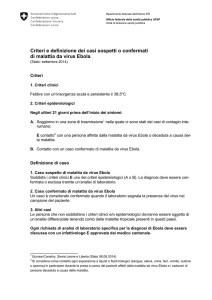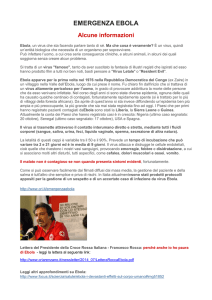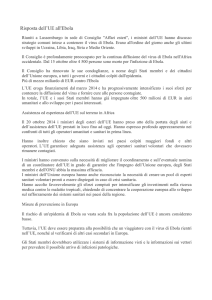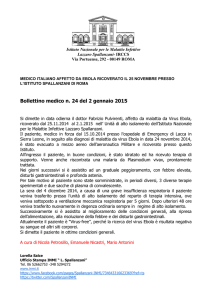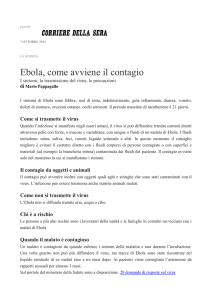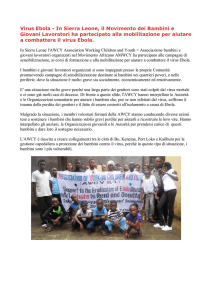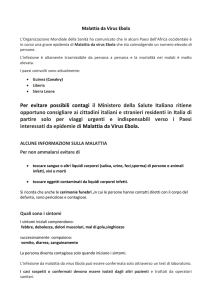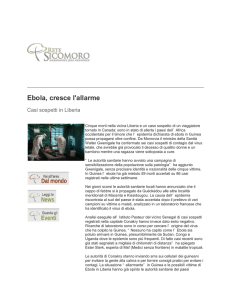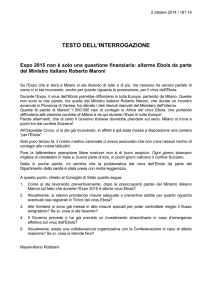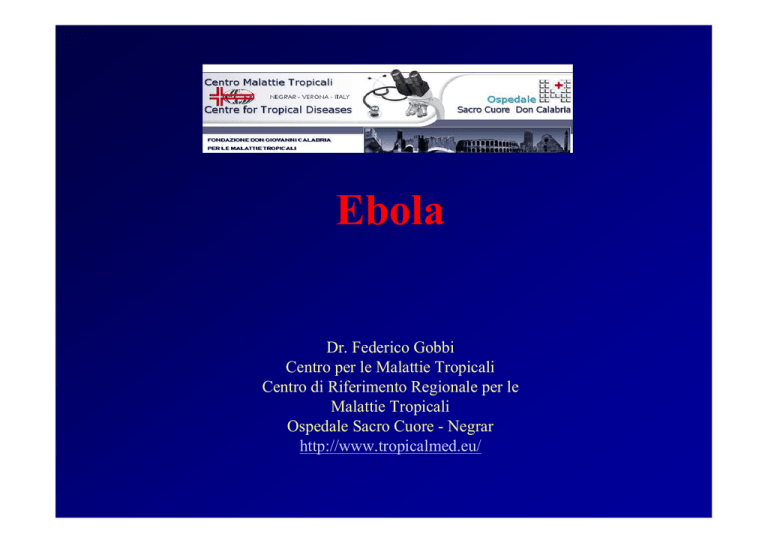
Ebola
Dr. Federico Gobbi
Centro per le Malattie Tropicali
Centro di Riferimento Regionale per le
Malattie Tropicali
Ospedale Sacro Cuore - Negrar
http://www.tropicalmed.eu/
IL VIRUS:
STRUTTURA MOLECOLARE
• Characterization of the virus
–
–
–
–
Order: Mononegavirales
Family: Filoviridae
Genus: Ebolavirus
Species: Ebola-Zaire, Ebola-Sudan, Ebola-Cote d-Ivoire, EbolaReston
• Morphology under electron microscope
– filamentous, enveloped RNA virus
– approx. 19 kb in length (1 kb = 1000 RNA
bases/nucleotides) or 60-80 nm in diameter
– single-stranded, linear, non-segmented
– negative-sense RNA (encoded in a 3’ to 5’ direction)
– appears to have “spikes” due to glycoprotein on
outside membrane
Outbreaks
• 1976- Primo Outbreak
maggiore (ZEBOV)
• 1976- Sudan
(SEBOV)
• Si verifica
sporadicamente
• Zone rurali/foresta alta mortalità
(epidemie
autolimitate)
Where does Ebola hide?
• 2002- Fruit Bats
• Antibodies against Ebola
• Ebola Gene sequences in
liver and spleen
• Fruit bats do not show any
symptoms
• Best candidate to be the
reservoir
• More research needs to be
done
Transmission
• contracted through contact of any infected
individual’s body fluids
Ebola HF prevention
poster used in Kikwit
outbreak.
Transmission
• When an infection does occur in humans,
the virus can be spread in several ways to
others. The virus is spread through direct
contact (through broken skin or mucous
membranes) with a sick person's blood or
body fluids (urine, saliva, feces, vomit, and
semen)
• objects (such as needles) that have been
contaminated with infected body fluids
• infected animals
Ebola 'could
become airborne':
United Nations
warns of
'nightmare
scenario' as virus
spreads to the US
Exclusive: Anthony
Banbury, chief of
the UN's Ebola
mission, says there
is a chance the
deadly virus could
mutate to become
infectious through
the air
Mutazione via di trasmissione
• Mai dimostrata nella
storia dell’umanità!
• Implica salti enormi nel
processo evolutivo
• Quindi sostanzialmente
impossibile
Quindi perché
allarmare?
Transmission ways of airborne pathogens
FONTE
1 METRO
TRASMISSIONE DA DROPLET
TRASMISSIONE AEREA
Quanto è resistente il virus
Ebola?
• Il virus Ebola viene ucciso facilmente da
sapone, candeggina, luce solare o
asciugatura. Il lavaggio in lavatrice di
indumenti contaminati da liquidi è
sufficiente a distruggere il virus Ebola. Il
virus Ebola sopravvive solo per breve
tempo su superfici esposte alla luce solare o
secche.
Not only malaria… 2. Haemorragic Fevers
• Exceedingly rare, but the most serious threat
• Difficult surveillance!!!
VHF virus
Geographic Distribution
Annual Cases
Ebola
Africa
<500
Marburg
Africa
<300
Lassa
Africa
100,000-300,000
S.America
Argentine pampas
~300
Hantaan
Asia, Europe
50,000-150,000
Rift Valley
Africa
100-100,000
(CCHF)
Euroasia, (Africa)
> 2000
Yellow F
Africa, South America
5,000-200,000
Dengue
Tropics, worldwide
DF: 100 million,
DHF: 100,000-200,000
Omsk
Siberia
100-200
Kyasanur
Karnataka state, India
400-500
Alkhumra
Saudi Arabia
<50
O. Ergonul. ECTMIH 2009
“La diffusione dell’ebola negli
Usa è inevitabile”
La Liberia dichiara lo stato di
emergenza
Allarme del responsabile del
centro di prevenzione delle
malattie: «Ma non ci sarà
un’epidemia». L’Ue: è come un
disastro al rallentatore
“La diffusione dell’ebola negli
Usa è inevitabile”
Poche settimane dopo…
Ebola, ricoverata in Turchia 23enne
italiana con sintomi sospetti
“La giovane aveva vomitato e accusato
febbre durante il volo proveniente dal
Ciad, scatenando il panico a bordo. Prima
di partire, però, le era stata diagnosticata
la malaria. Trasferita subito in ospedale, è
stata posta in isolamento…”
Ebola, falso allarme a Gallarate:
torna con la febbre dalla Costa
d'Avorio, ma era malaria
“Sala d'attesa evacuata in pronto soccorso,
chiuso per tre ore dalle 10.30. Dopo i test
medici, si è scoperto che per fortuna non c'era
traccia del devastante virus, anche se il falso
allarme aveva già fatto in tempo a diffondersi”
„The Dirty Dozen“
1. Bacillus anthracis
7. Coxiella burnetii
2. Brucella spp.
8. Francisella tularensis
3. Yersinia pestis
9. Burkholderia mallei
4. Marburg virus
10. Botulinum toxins
5. Variola virus
11. Ricin
6. VEE virus
12. Staphylococcal
enterotoxins
Adapted from Dr. Roman Wölfel, VI ECTMIH Verona 2009
26
Not only malaria… 2. Haemorragic Fevers
Marburg epidemic, Uige, Angola, 2005
E De Vivo, ECTMIH 2009
Not only malaria… 2. Haemorragic Fevers
Ebola epidemic, Bundibugyo, Uganda, 2007-08
P Roddy , ECTMIH 2009
Epidemie passate e attuale
Proiezioni
Proiezioni
On July 5, 2008, a 41-year-old woman was referred by
her general practitioner to the Elkerliek Hospital
because of fever (39°C) and chills of 3 days' duration
after returning from a June 5–28 holiday in Uganda.
She was placed in a hospital room with 3 other
patients. Malaria was ruled out by 3 negative blood
films. …….
On July 7, hemorrhagic fever was included ….. in the
differential diagnosis because of rapid clinical
deterioration and impending liver failure.
Timen A, Koopmans MPG, Vossen ACTM, van Doornum GJJ, Günther S, van den Berkmortel F, et al.
Response to imported case of Marburg hemorrhagic fever, the Netherlands. Emerg Infect Dis [serial on the
Internet]. 2009 Aug [date cited]. Available from http://www.cdc.gov/EID/content/15/8/1171.htm
MARBURG HEMORRHAGIC FEVER - THE NETHERLANDS
ex UGANDA * A ProMED-mail post
<http://www.promedmail.org> Date: Thu 10 Jul 2008 Source:
European Centre for Disease Prevention and Control (ECDC)
[edited] <http://ecdc.europa.eu/index.html>
• On Thu 10 Jul 2008, … one confirmed case of Marburg fever
diagnosed in the Leiden University Medical Centre.
• 40-year-old woman returned from Uganda caves in the
Maramagambo forest, exposed to fruit bats
MARBURG HEMORRHAGIC FEVER - UNITED
STATES OF AMERICA ex UGANDA 2008 (02) *
MMWR 2009; 58(49): 1377-81
Imported case of Marburg hemorrhagic fever Colorado, 2008.
• 9 Jan 2008… unexplained febrile illness
• woman who had returned from travel in Uganda
• no evidence of … tropical febrile illnesses,
including VHF.
• Six months later, in July 2008, the patient
requested repeat testing after she learned of the
death from MHF of a Dutch tourist …...
• Convalescent serologic testing revealed evidence
of prior infection with MARV, and MARV RNA was
detected in the archived early convalescent serum.
Controlling the spread of Ebola
• a. Hospitals must follow precautionary methods, such as:
1. wearing gloves
2. isolating infected individuals
3. practicing nurse barrier techniques
4. proper sterilization and disposal of all equipment
• b. Burials must be done correctly
1. no washing or touching carcass
2. put into body bags and bury outside city
• c. Report any questionable illness to officials
Ebola: fatti e miti
29/10/2014
Dr. Andrea Angheben
Centro per le Malattie Tropicali
Centro di Riferimento Regionale per le
Malattie Tropicali
Ospedale Sacro Cuore - Negrar
http://www.tropicalmed.eu/
Il virus arriverà da noi?
• Sinora i casi di Ebola fuori dall’area
epidemica hanno colpito per lo più operatori
sanitari
• Tempo di incubazione (max 21 gg, in
genere meno di 10)
• No trasmissione in fase di incubazione
Proiezioni
• Come può arrivare in Italia?
- Rimpatrio protetto
- Viaggiatore in periodo di incubazione/sfuggito ai
controlli
• Come può diffondersi in Italia?
- Principalmente attraverso errore
gestionale/operatori sanitari (Dallas, USA e
Madrid, Spagna)
Media 2,8 viaggiatori infetti da MVE al
mese lasciano i Paesi con epidemia
• Il 60% circa dei
• Screening di uscita
viaggiatori (aereo) dai
molto utile
paesi con epidemia da • In entrata inutile
virus Ebola è diretto
verso altri Paesi poveri
http://www.mobs-lab.org/ebola.html
Definizione del rischio
(Ministero della Salute)
Definizione del rischio
(Ministero della Salute)
Definizione del rischio
(Ministero della Salute)
TRATTAMENTO
• Idratazione, bilancio
elettrolitico
• Ossigenazione
• Mantenimento PA
adeguata
• Trattamento di
infezioni intercorrenti
TRATTAMENTO
What is ZMapp?
Tx sperimentale a base di 3 Ab
monoclonali anti-Ebolavirus
Trasporto del Sacerdote spagnolo successivamente deceduto
TRATTAMENTO
Brincidofovir?
Tx sperimentale con derivatro del
cidofovir, antivirale per virus a DNA (?)
Effetto sulla replicazione virale in vitro…
Trasporto del Sacerdote spagnolo successivamente deceduto
VACCINO
On August 28, 2014,
NIH announced that
initial human testing of
an investigational
vaccine to prevent
Ebola virus disease will
begin next week by the
National Institute of
Allergy and Infectious
Diseases (NIAID), part
of the National
Institutes of Health
2016??
L’Istituto Nazionale per le Malattie
Infettive Lazzaro Spallanzani
Istituto Nazionale per le Malattie Infettive
Lazzaro Spallanzani- Roma
Main facilities and technologies available for
research and clinical care
• Clinical wards (until 340 beds) for isolation of patients with
airborne and highly contagious infections.
• 5 Biosafety Level (BSL) 3 containment laboratory, and 1
BSL4 area for the maximum containment.
CELLULA TIPO ALTO ISOLAMENTO
High containment ambulance
Stretcher isolator for initial patient retrieval
GRAZIE!

